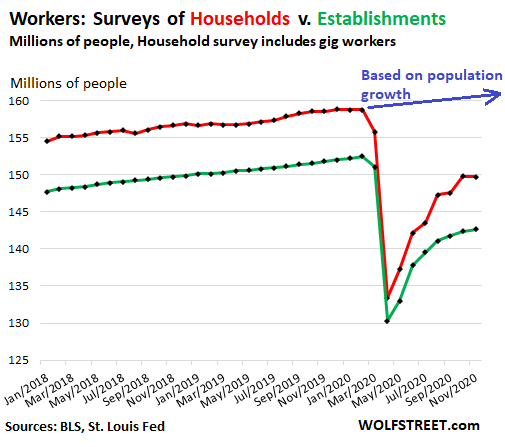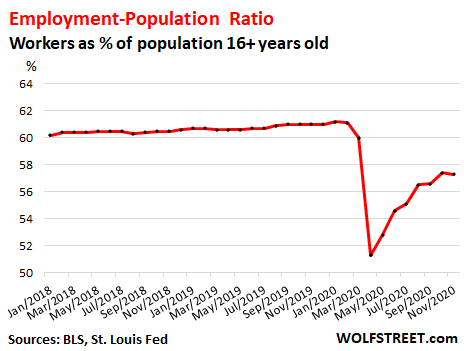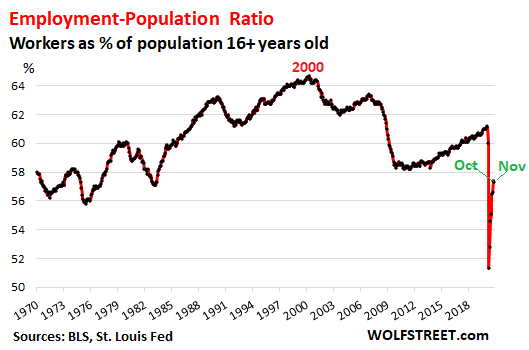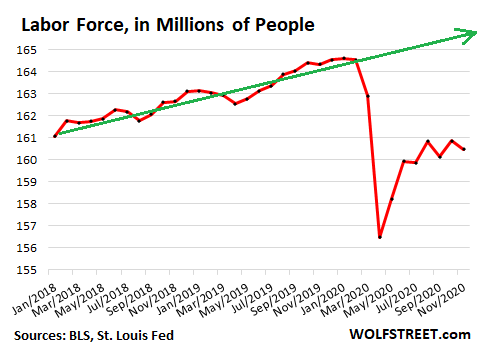Yves here. As Wolf describes, the data is the latest jobs figure were sobering and didn’t reflect the current Covid spike, which was just getting steam as of the reporting date.
Needless to say, things will get worse before they get better. And an awful lot of hope is being pinned on the vaccines taming Covid quickly.
By Wolf Richter, editor of Wolf Street. Originally published at Wolf Street
Everyone seems to be baking the highly anticipated potential future vaccines into the economic cake, but what has been happening for weeks is a spike in Covid cases across the US that has already triggered economic restrictions, including various versions of stay-at-home orders in Los Angeles County, San Francisco, and some other Bay Area counties, with restaurants closed for outdoor dining, strict capacity restrictions in retail stores, and many other restrictions. These moves are ahead of the State of California’s new framework for dealing with the spiking infections.
Other states and cities have similar programs, either on the front burner or on the back burner. The Covid spike has already crimped economic activity and jobs over the past few weeks and is going to do more severely going forward.
But the jobs report released today by the Bureau of Labor Statistics was based on surveys of “establishments” for the pay period through November 12; and on surveys of households for the week through November 14.
So the data we got today largely missed the labor market consequences of the spike in Covid cases. Those consequence are coming in the next employment reports, starting with the report for December.
Despite the cut-off dates having kept much of the Covid-impacted jobs data out of the results, the data have actually deteriorated in several aspects, including the number of people with jobs as reported by households, the employment-population rate, and the labor force.
The headline number of 245,000 jobs created came from surveys of establishments (companies, governments, nonprofits, educational institutions, etc.). That survey doesn’t track gig workers. It depicted a lousy recovery. But lousy as it was, it was the more benign part.
The survey of households, on the other hand, tracks people who are working full or part time, including gig workers. And households reported that the number of people with jobs ticked down to 149.7 million. This wasn’t a slowdown in growth, but an actual decline of 74,000 working people – the first month-to-month decline since April.
The chart shows both results, from establishments (green) and from households (red) – the biggest part of the difference being gig workers. It’s obvious that even by November 12, before the real impact of the Covid surge, this was no good, in terms of catching up with population growth, or in terms of anything else:

The employment-population ratio, which tracks the number of employed workers against the working-age population (16 years or older) also dipped in November, to 57.3%, a level first seen since in 1972:

Over the long term, the employment-population ratio tracks the progress of globalization – of corporate America outsourcing labor to cheap countries – not only manufacturing and all the economic support that comes with it, but also all kinds of intellectual property work, such as coding and automotive design, and all kinds of other service work, from call centers to basic lawyering. This movement took on momentum in the late 1990s.
Since then, after each crisis, companies offshored more work, and the employment-population ratio recovered from the plunge, but not to its previous level, before the next crisis hit and the plunge started all over again, from lower highs to lower lows:

The labor force is composed of people who answer questions in the household surveys that indicate they are either working or are looking for a job, as defined by the BLS. People who want a job but haven’t looked for a job in the specified period are knocked out of the labor force.
During the early months of the Pandemic, the laid-off workers were still on earth, but they didn’t look for a job because it was hopeless. Then the labor force recovered through August, and stalled. In November – household surveys through November 14 – the labor force ticked down again, falling below where it had been in August:

So this employment data, as dreary as it is, attempted to capture the labor market conditions the way they were through November 14. In the three weeks since then, conditions have worsened, and they’re in the process of worsening further with the renewed restrictions now rippling across the country, and December is going to be rougher on the employment front.
Office occupancy plunged by the most in Dallas. In San Francisco, where it had already been rock-bottom, it dipped into the single digits. Read… The State of the American Office: Suddenly Emptying Out Again Under the Second Wave


We are going to find that restaurants and bars have been a kind of unofficial safety net for millions of relatively unskilled workers.
This sector has enabled many state and local governments to more or less ignore the gaps and inefficiencies in their unemployment systems. Of course this is most true in the red states, which compete on who can levy the lowest taxes on employers, and who can drive away the kind of people who grow dependent on social services.
The only answer to federalize the unemployment system and fund it through Social Security.
Ironically this is what the New Dealers really wanted in the 1930’s. But the Supreme Court at that time was vetoing most nationalized programs, so this had to go through as a convoluted federal-state enterprise.
I would not characterize restaurant staff as relatively unskilled. Ir would be more accurate to say they are relatively un-credentialed.
If we are talking about people who work in kitchens, Grimm is right: That is definitely not unskilled labor.
I agree. It takes a lot of skill to be competent in a kitchen. It takes a lot of skill to do a good job waiting tables too. But we don’t pay for those skills it seems :/
You can’t fund it through social security if there are few people working. That would put an enormous tax burden on women and poc who make up the majority of essential workers.
The government can just create money and pay us to stay home. No “funding” required.
Stock prices are rising, as are housing prices in many parts of the United States, yet at the same time millions are on the precipice of hunger and homelessness.
There is something very wrong with this picture.
it’s called a K-shaped recovery; one leg goes up, the other leg goes down…
So the country does the splits – again
It doesn’t “get real” in the media’s and some people’s minds until the PMC starts getting laid off. Then stocks and housing prices likely will start to fall. When that happens, not sure. I think it’s a balance between fiscal stimulus vs economic reality and out of whack P/E ratios.
Yes, massively wrong. As to the stock prices, the Fed has been pumping no cost money into Wall St since 2008 with the last estimate I have seen that the combined total of zero cost money being in excess of $35 trillion dollars. Here is one such study:
$29,000,000,000,000: A Detailed Look at the Fed’s Bailout by Funding Facility and Recipient:
http://www.levyinstitute.org/pubs/wp_698.pdf
It’s much more difficult to get information on home buying activities, but the local newspaper mentioned that about 30% of the homes being sold in my area are being purchased by Private Equity as an INVESTMENT. In other words, hedge funds and other PE that traditionally invested in the market is now buying and renting homes. They have access to all that Fed cash, and can drive up home prices quite easily.
you know you truncated wolf’s post and left off the bottom part with the two graphs.
No, there are four charts and all four charts are visible, and the post ends with this:
Office occupancy plunged by the most in Dallas. In San Francisco, where it had already been rock-bottom, it dipped into the single digits. Read… The State of the American Office: Suddenly Emptying Out Again Under the Second Wave.
It just occurred to me that with the Financial district offices is likely going bye bye that means that Market can finally die as it necrosis spreads from the dead southwest and to the Ferry Building in the Northeastern terminus; yeah, the City’s families like the Pelosis and Feinsteins sure made a good decision to dump the Port of San Francisco’s shipping although the unions were too fixated on the immediate job losses. Oakland jumped on building the expensive container port and took away San Francisco’s business.
So let’s see, much of the shipping, warehouses, light industries, and heavy manufacturing especially marine related, but not only, starting disappearing around 1960(?). Too bad it was before my time as I would have liked to have seen it as I am sure many people in places like Camden, Flint, and Detroit.
And all this death is being camouflaged with bogus statistics.
we don’t need manufacturing anymore. we can just print what we need on 3d printers in the safety of our homes. Too much disease any hate out in the streets these days.
And like with HP who will own whatever is the equivalent of the ink cartridges and maintenance contracts?
Anyways, people have been saying that the Satanic Machine™️ is stealing everyone’s job. Perhaps, but I think that much of the push for the often dysfunctional machines is to get rid of the pesky people; it’s not because the machines are always better, but they just don’t want to have to talk or deal with filthy humanity.
your highness, here’s the source code. Everything under that adsbygoogle tag is not visible in chrome
..Those consequence are coming in the next employment reports, starting with the report for December.
div class=”in-article-ad”> ins class=”adsbygoogle” data-ad-layout=”in-article” data-ad-format=”fluid” data-ad-client=”ca-pub-8212587530282873″ data-ad-slot=”4886511358″ data-adsbygoogle-status=”done ins id=”aswift_2_expand” tabindex=”0″ title=”Advertisement” aria-label=”Advertisement” ins id=”aswift_2_anchor”>
ALL TEXT NOW MISSING:
Despite the cut-off dates having kept much of the Covid-impacted jobs data out of the results, the data have actually deteriorated in several aspects, including the number of people with jobs as reported by households, the employment-population rate, and the labor force.
No, the full text of the article and all the charts are in the backstage and visible when I view the site in Safari and Firefox, in both cases when I am not logged in as a site admin. More important, you are the only reader to complain. The very first comment and all succeeding comment would have said there was something wrong with the post if they got the same results as you did.
You must have an odd setting in your browser. How could I possibly have cut and pasted the text I provided above, from an external view of the site, if it wasn’t loaded?
You’ve violated site Policies by sock-puppeting (using 2 different handles when you are the only person to complain and complained twice, trying to make it look like it was a second reader when it wasn’t).